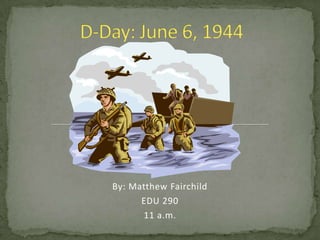
D Day
- 1. D-Day: June 6, 1944 By: Matthew Fairchild EDU 290 11 a.m.
- 2. Introduction An excerpt from www.army.mil (the official website of the U.S. Army): “June 6, 1944, 160,000 Allied troops landed along a 50-mile stretch of heavily-fortified French coastline to fight Nazi Germany on the beaches of Normandy, France. General Dwight D. Eisenhower called the operation a crusade in which “we will accept nothing less than full victory.” More than 5,000 Ships and 13,000 aircraft supported the D-Day invasion, and by day’s end on June 6, the Allies gained a foot- hold in Normandy. The D-Day cost was high -more than 9,000 Allied Soldiers were killed or wounded -- but more than 100,000 Soldiers began the march across Europe to defeat Hitler.” –U.S. Army Website
- 3. 1939: Germany invades Poland After negotiations for Germany to withdraw fail, Britain and France declare war on Germany 1940: June: Germany captures Paris, France surrenders to Hitler July: The Battle of Britain begins, a three month battle fought in the skies over Britain Prior Events
- 4. U.S. Enters WWII… 1941: Japan attacks American naval fleet at Pearl Harbor U.S. declares war on Japan Three days later, Germany and Italy declare war on U.S. Pearl Harbor during Japanese attack (http://www.flickr.com/photos/savageman2003/398579964/in/photostream/)
- 5. U.S. and Allied Forces Become Aggressive… 1942: U.S. troops arrive in Europe Russian forces hold off Germany’s attempt to capture Stalingrad. 1943: U.S. and British troops defeat Germany in North Africa Allied forces capture Sicily, and parts of Southern Italy. 1944: More than 600 U.S. bombers begin an assault on Berlin Allied forces capture Rome, Italy Allied forces mobilize in an attempt to capture territories in France Invasion of Normandy set for June 5, 1944; had to be delayed because of bad weather conditions.
- 6. D-Day Objectives Land on 5 beaches, stretching 50 miles along coast of Normandy, France. Beach codenames: Utah, Omaha, Gold, Juno, and Sword Secure the coastline in order to mobilize troops to liberate France from German control Gen. Dwight D. Eisenhower briefing American troops before invading Normandy (http://www.flickr.com/photos/soldiersmediacenter/2561212534/in/set-72157605500980913/)
- 7. The Attack Begins Began from the air Paratroopers main task was to capture bridges. Capturing bridges would eliminate possibility of effective German counter-attack. 3 hours into attack, 5000 Allied fighters defeated 119 enemy aircrafts. Attack from the sea 3,000 landing crafts, 2,500 other ships, and 500 naval vessels arrived off the coast 4 hours into the battle. 7 battleships and 18 cruisers attacked enemy defenses along the 5 beaches.
- 8. Taking the Beaches American troops storm Utah and Omaha Canadian troops storm Juno British troops storm Gold and Sword Utah, Juno, Gold, and Sword captured without many casualties, or much German resistance American forces at Omaha face strong German resistance; become pinned back against water, with increasing casualties. US infantrymen storm Omaha beach (http://www.flickr.com/photos/soldiersmediacenter/2560388523/)
- 9. American troops lost tank support; all but two amphibious tanks were sunk. Landing crafts had trouble reaching the shore because of strong German resistance Small groups of American troops, who had been separated from their regimen, attacked Germans from behind and from the sides. Americans were no longer pinned back due to the help from small groups of American forces, and were able to advance onto land eventually. The Battle at Omaha
- 10. D-Day Winds Down British infantry advancing inland met heavy German resistance, but were able to defeat enemy forces. Hitler withdraws reserve troops, and leaves only one division of troops to fight off British infantry. All 5 beaches are eventually secured once American troops receive support from British and Canadian Forces Allied forces begin to move inland, meeting only limited German resistance. German troops surrender on the beaches of Normandy, France. (http://www.flickr.com/photos/soldiersmediacenter/2561211540/in/set-72157605500980913/)
- 11. By the end of D-Day, the Allies landed 130,000 troops by land, and 29,000 troops by air. Allied casualties (meaning killed, wounded, missing, or captured) for D-Day are estimated at 10,000 men. Over 2,500 Allied troops died on D-Day. Most consider D-Day to be the beginning of the end of Germany’s hold over Europe. May 7, 1945: Germany unconditionally surrenders to Allied forces in Europe. The End Of D-Day
- 12. http://www.army.mil/D-day/ http://www.pbs.org/wgbh/amex/dday/ http://www.history.com/content/worldwartwo/d-day-timeline http://www.britannica.com/dday Resources